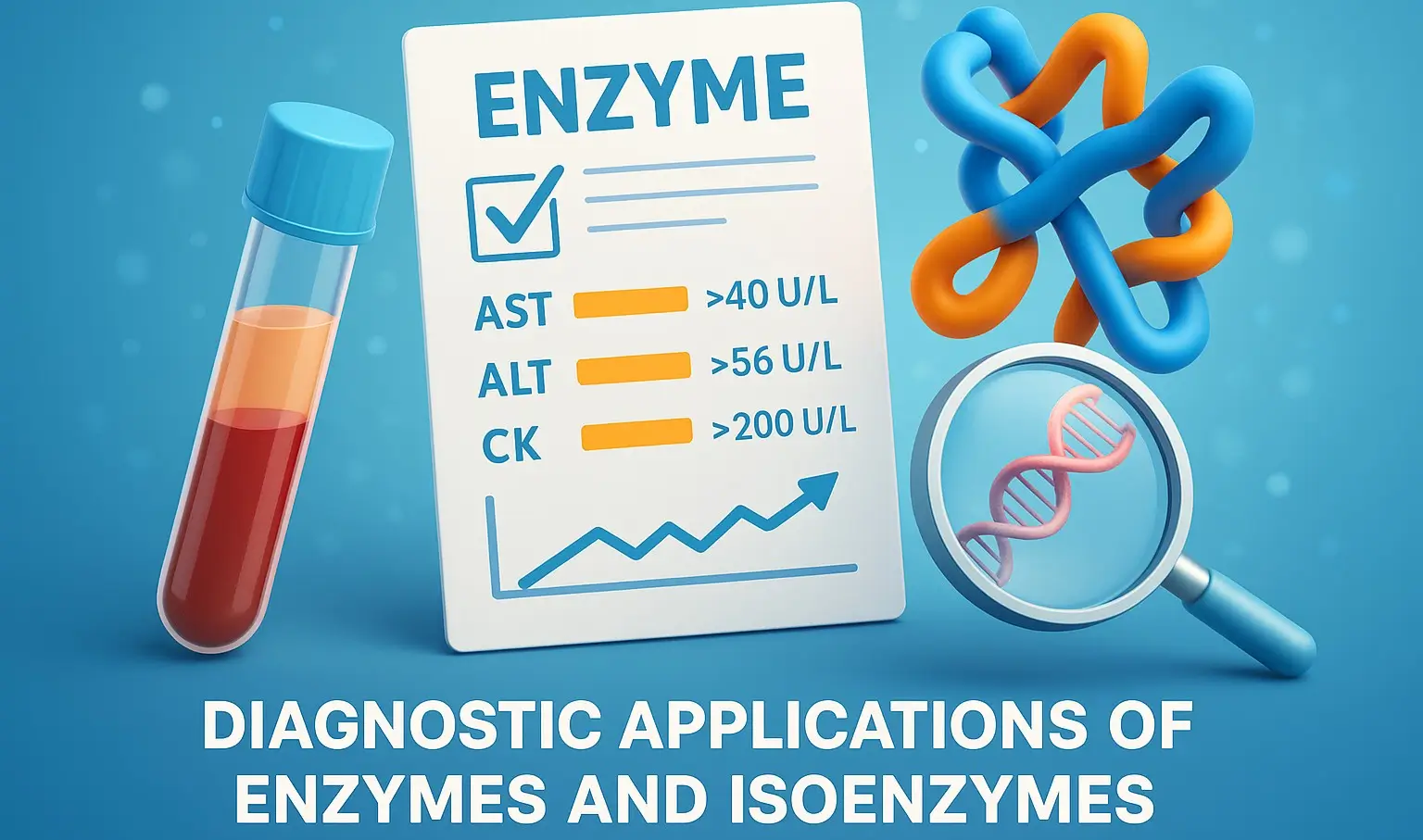- Diagnostic applications of enzymes and isoenzymes refer to the use of specific enzyme activity levels and the patterns of their isoforms (isoenzymes)
- In Diagnostic Applications body fluids such as blood, urine, or cerebrospinal fluid as biomarkers to diagnose, monitor, or assess the progression of diseases.
- Because enzymes and their isoenzymes are often organ-specific, their presence or elevation in abnormal quantities can help identify tissue damage, organ dysfunction, or particular disease states
Biomarkers for Tissue Damage:
- Creatine Kinase (CK) Isoenzymes:
- CK-MB: Predominantly found in cardiac muscle; elevated levels indicate myocardial infarction.
- CK-MM: Found in skeletal muscle; increased levels suggest muscle damage.
- CK-BB: Located in the brain; elevated levels may indicate brain injury.
- Clinical Use: Measuring CK-MB levels helps diagnose heart attacks and assess the extent of cardiac damage.
Lactate Dehydrogenase (LDH) Isoenzymes:
- LDH-1 to LDH-5: Each isoenzyme is associated with specific tissues (e.g., LDH-1 in the heart, LDH-5 in the liver and muscles).
- Clinical Use: The pattern of LDH isoenzymes can help diagnose myocardial infarction, liver disease, and hemolytic anemia.
Alkaline Phosphatase (ALP) Isoenzymes:
- Bone and Liver Isoenzymes: Elevated bone ALP suggests bone disorders like Paget’s disease, whereas increased liver ALP indicates hepatobiliary diseases.
- Clinical Use: Differentiating between bone and liver disease based on ALP isoenzyme levels.
Pancreatic Enzymes:
- Amylase and Lipase: Elevated serum levels indicate acute pancreatitis.
- Clinical Use: Diagnosing pancreatic inflammation and monitoring treatment efficacy.
Prostate-Specific Antigen (PSA):
- Enzyme Type: A serine protease produced by prostate tissue.
- Clinical Use: Elevated PSA levels can indicate prostate cancer or benign prostatic hyperplasia.
Enzyme-Linked Immunosorbent Assay (ELISA):
- Principle: Uses enzymes as labels to detect specific antigens or antibodies in a sample.
- Clinical Use: Diagnosing infections (e.g., HIV, hepatitis), allergies, and measuring hormone levels.
Glucose Monitoring:
- Enzymes Used: Glucose oxidase or hexokinase in assays to measure blood glucose levels.
- Clinical Use: Managing diabetes by monitoring glycemic control.
Newborn Screening:
- Enzyme Assays: Detect metabolic disorders by measuring enzyme activity or metabolite levels.
- Examples: Phenylketonuria (PKU), where phenylalanine hydroxylase activity is deficient.
Genetic Testing for Enzyme Deficiencies:
- Purpose: Identifying mutations in genes encoding enzymes to diagnose inherited metabolic disorders.
- Clinical Use: Facilitating early intervention and genetic counseling.
Drug Metabolism and Pharmacogenomics:
- Cytochrome P450 Enzymes: Isoenzymes involved in drug metabolism.
- Clinical Use: Determining patient-specific drug metabolism rates to personalize medication regimens and avoid adverse effects.
Significance of Isoenzymes in Diagnosis
- Tissue Specificity: Isoenzymes allow clinicians to pinpoint the source of enzyme elevation, as different tissues express different isoenzymes.
- Diagnostic Accuracy: Measuring specific isoenzymes enhances the accuracy of diagnosing organ-specific damage or disease.
- Temporal Patterns: Isoenzymes may have varying release patterns following tissue injury, aiding in determining the timing of events like myocardial infarction.

